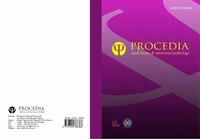Meningkatkan kemampuan rawat diri pada anak dengan autism spectrum disorders
DOI:
https://doi.org/10.22219/procedia.v10i2.19010Keywords:
Autism spectrum disorders, self care, positive reinforcementAbstract
Autism Spectrum Disorders (ASD) affects all aspects of individual development, including the ability to perform self-care activities, daily living, communication skills and social participation. In this case, the subject experienced a delay in speaking accompanied by symptoms of very poor eye contact, laughing excessively and without reason, speaking a language that was difficult to understand and often grasping the fingers of both hands and moving his feet which resulted in experiencing difficulties in carrying out his daily tasks such as bathing, dressing and eating is included as part of self-care. The assessments used were interviews, observation, Progressive Matrices Test for Children (CPM) and The Childhood Autism Rating Scale (CARS). The intervention given to improve the subject's self-care skills is the provision of positive reinforcement. The results of the intervention that has been given to the subject, behavioral therapy with positive reinforcement techniques are able to improve basic abilities in self-care, especially bathing to washing the face and head, dressing in button-up clothes and eating by not cleaning dirty hands on the clothes worn.
Downloads
References
Alsedrani, R. A. (2017). Using Individual Positive Reinforcement Strategies to Enhance Task Completion in Children with Autism Spectrum Disorders. American Research Journal of Humanities and Social Sciences, 3(1), 1.10.21694/2378-7031.17001
American Psychiatry Association. (2013). Diagnostic and stastical manual of mental disorder (fifth edit). Washington DC: American Psychiatry Association.
Angelidou, A., Asadi, S., Alysandratos, K. D., Karagkouni, A., Stella K., & Theoharides, T. C. (2012). Perinatal Stress, Brain Inflammation and Risk of Autism Review and Proposal. BMC Pediatrics, 12–89.
Boyadjieva, N., & Varadinova, M. (2015). Role of Fetal Alcohol Exposure on Molecular and Epigenetic Mechanisms of Autism. Recent Advances in Autism, 1–10.
Bumin, G., Huri, M., Salar, S., Kayihan, H. (2015). Occupational therapy in autism. In: Autism Spectrum Disorder. Canada: Intech.
Carbone, V. J., O’Brien, L., Kerwin, E. J., & Albert, K. M. (2013). Teaching Eye Contact to Children with Autism: A Conceptual Analysis and Single Case Study. Education and Treatment of Children, 36(2), 139–159. https://doi.org/10.1353/etc.2013.0013
Corey, G. (2017). Teori dan praktek konseling & psikoterapi. Bandung: Radika Aditama.
Feist, J., Feist, G. J., & Roberts, T.-A. (2018). Theories Of Personality (Ninth Edit). New York: McGraw Hill.
Flynn , L., & Healy, O. (2012). A Review of Treatments For Deficits in Social Skills and Self Help Skills in ASD. Research in Autism Spectrum Disorders 6, 431–441. 10.1016/j.rasd.2011.06.016
Fridolina, E. P., Deliana, . M. & Pranoto, Y. K. S. (2019). The Training of Self-Help Eating Ability of the Autism Spectrum Disorder Student using Social Reinforcement Intervention in Early Childhood. Journal of Primary Education, 11(1), 85–91. 10.15294/jpe.v11i1.36055
Gal, E., Ben Meir, A., & Katz, N. (2013). Development and reliability of the Autism Work Skills Questionnaire (AWSQ). The American Journal of Occupational Therapy: Official Publication of the American Occupational Therapy Association, 67(1). 10.5014/ajot.2013.005066
Hakobyan, A., & Harutyunyan, Z. (2021). The Importance of Self-Care Skills Development for Children With Autistic Spectrum Disorder From the Parents’ Perspective. Journal of Special Education, 4(2), 21–38. https://doi.org/10.24234/se.2021.4.2.271
Hallahan, D.P., & Kauffman, J. M. (2014). Exceptional learners:An introduction to special education (12th editi). USA: Education Limited.
Hwang, Y. S., Weng, S. F., Cho, C. Y., & Tsai, W. H. (2013). Higher prevalence of autism in Taiwanese children born prematurely: A nationwide population-based study. Research in Developmental Disabilities, 34(9), 2462–2468. 10.1016/j.ridd.2013.05.019
Lucker, K. D. (2009). Review of Self-Help Skills for People with Autism: A Systematic Teaching Approach by Stephen R .Anderson, Amy L. Jablonski, Marcus L. Thomeer, and Vicki Madaus Knapp. Behavior Analysis in Practice, 2(1), 65–67. 10.1007/BF03391740
Miltenberger, R. G. (2012). Behavior modification: principles and procedures. Canada: Wadsworth Cengage Learning.
Mumpuniarti. (2003). Ortodidaktik Tunagrahita. Yogyakarta: FIP UNY.
Murpratiwi, I. A., & Tjakrawiralaksana, M. A. (2018). Prompting dan Positive Reinforcement untuk Meningkatkan Keterampilan Berpakaian Pada Anak dengan Intellectual Disability. Jurnal Psikologi Teori Dan Terapan, 1(1), 112–123. https://doi.org/10.26740/jptt.v8n2.p112-123
Nevid, J. S. Rathus, S. A. & Greene, B. (2014). Psikologi Abnormal (Edisi Kese). New York: McGraw Hill.
Nevid, J. S., Rathus, S. A., & Greene, B. (2005). Psikologi abnormal. Jakarta: Erlangga.
Onore, C., Careage, M., & Ashwood, P. (2012). The Role of Immune Dysfunction in the Pathophysiology of Autism. . . Brain Behav Immun, 26(3), 383–392. 10.1016/j.bbi.2011.08.007
Prabowo, A. S., & Cahyawulan, W. (2016). Pendekatan Behavioral: Dua Sisi Mata Pisau.
Santrock, J. W. (2012). Life-span Development (13th Editi). University of Texas, Dallas: :McGraw-Hill.
Schmidt RJ, Hansen RL, Hartiala J, Allayee H, Schmidt LC, Tancredi DJ, Tassone F, H.-P. I. (2011). Prenatal vitamins, one-carbon metabolism gene variants, and risk for autism. Epidemiology, 22(4), 476–485. 10.1097/EDE.0b013e31821d0e30
Sudrajat, Dodo & Rosida, L. (2013). Pendidikan Bina Diri Anak Berkebutuhan Khusus. Jakarta: Luxima Metro Media.
Young, A. M. H., Chakrabarti, B., Roberts, D., Lai, M., Suckling, J., & Baron-Cohen, S. (2016). From Molecules to Neural Morphology: Understanding Neuroinflammation in Autism Spectrum Condition. Molecular Autism, 7(9), 1–8.
Downloads
Published
How to Cite
Issue
Section
License
Copyright (c) 2022 Diesmy Humaira Biruny

This work is licensed under a Creative Commons Attribution-NonCommercial 4.0 International License.






